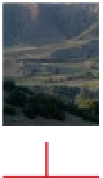Geology Reference
In-Depth Information
temperature, the ductility of a rock will
depend critically on the pore-fluid pres-
sure. This is very important in under-
standing how large thrust sheets move,
as we shall see in the following chapter.
The yield strength of rocks is thus
dependent both on temperature and
effective pressure, but the effect of
temperature becomes more important
at greater depth. Consequently, rock in
general will become stronger with depth
in the crust down to a critical level at
which the strength reaches a maximum
value, below which it decreases as the
temperature increases. This level will
be reached at different places with dif-
ferent rocks, but in general will lie at
mid-crustal levels. Here there is a transi-
tion between broadly brittle behaviour
and broadly ductile behaviour in a zone
known as the
brittle-ductile transi-
tion
, usually regarded as between 15 km
and 20 km depth in normal continental
crust, below which earthquakes are not
usually generated. An alternative way
of looking at this is to compare the dif-
ferential stress required to maintain a
geologically realistic strain rate with
increasing depth as shown schemati-
cally in Figure 4.11. Studies of real rocks
in laboratory experiments indicate
that the variation in the yield strength
is significantly affected by important
changes in the mechanism of defor-
mation, which we shall now discuss.
rocks are aggregates of crystals or grains,
in most cases involving several differ-
ent mineral types, their deformation
will depend on the various responses of
the different minerals to stress. Another
important factor is the influence of
the temperature-pressure environ-
ment during the deformation, since
this affects the way in which individual
minerals deform. The behaviour of the
weakest minerals in a deforming rock
is critical, since this controls the strain
of the whole rock; in the case of many
rocks, this mineral is quartz; in others it
is feldspar, or calcite; and in the case of
mantle materials, it is olivine; and much
experimental work has been done on
these minerals. Unfortunately, the short
time periods available for experimental
deformation means that the strain rates
achieved during this deformation are
much too high (around 10
-7
per second,
equivalent to 300% per year), whereas
we know from plate tectonic veloci-
ties that strain rates for lithospheric
deformation should be in the range
4
28
29
increasing differential stress
mechanism
fabric type
grain size
granular flow
wet
rocks
grain-size
reduction
brittle
behaviour
cataclastic
flow
dry
rocks
shape
fabrics
increasing
temperature
+ effective
pressure
with depth
brittle-ductile
transition
dislocation
creep
orientation
fabrics
ductile
behaviour
diffusion
creep
shape
fabrics
grain-size
increase
geologically
realistic
strain rate
How rocks deform
The various models of deformation
discussed above treat rocks as uniform
materials in analysing their response
to stress. However, to understand their
behaviour in practice, it is necessary to
examine rocks in detail, on a small scale,
especially under the microscope. Since
Figure 4.11
Schematic deformation diagram showing the fields occupied by the various types of
viscous permanent strain associated with increasing depth (i.e. increasing temperature and effective
pressure) and increasing levels of differential stress. The red line represents the behaviour of an
imaginary rock material deforming at a geologically realistic strain rate (usually assumed to be around
10
-14
per sec). At low temperature and high differential stress, viscous deformation takes place by
granular flow or, with increasing lithostatic pressure, by cataclastic flow. The strength increases with
depth to a maximum at the brittle-ductile transition. Above this level is brittle behaviour, dominated
by fracture processes and leading to grain-size reduction. At higher temperatures, lower stresses are
required to produce the equivalent strain rate. The mechanisms here are dislocation creep and, at
higher temperatures again, diffusion creep. This is ductile behaviour, leading to grain-size increase.





















Search WWH ::

Custom Search